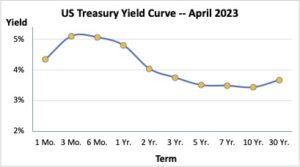Inverted Yield Curves
You may have noticed that we currently have an inverted yield curve for US Treasury debt or, you may have no idea what I’m talking about. I’ll explain.
What is it?
An inverted yield curve is when interest rates on shorter term fixed income securities are higher than on longer term ones. For example, the yield on a 3-month Treasury Bill is currently 5.1%, while a 5-year Treasury Bond is yielding 3.5% and a 30-year is 3.7%.
It’s unusual for longer term interest rates to be lower than short term rates. You can also see this with bank CDs. At my favorite bank, Ally, the rate for a 1-year CD is higher than the rate for a 3-year CD. You don’t see that very often.
Here a graphical view of the yield curve for US Treasury securities as of April 2023:

If you’re curious, the US Treasury tracks the numbers here.
What is typical?
Longer term bonds and CDs normally have higher interest rates to compensate investors for the risks of locking up their funds for a longer period of time.
If this were not the case, you’d expect bond investors to instead invest in shorter term bonds and continually roll them over to maximize their returns. With an inverted yield curve, bond investors are willing to lock into longer terms at lower rates of return. Why would they do that?
Why would rates invert?
Essentially, the collective wisdom of bond investors is that they expect future short-term interest rates to be lower than today, with a recession possibly on the horizon. With or without a recession, they expect weaker economic growth in the coming years.
During a recession, the Federal Reserve Bank typically lowers short term interest rates to jump-start the economy into faster growth. Thus, the lower long-term rates of today (the inverted yield curve) reflect the consensus view that future short-term rates will be lower than they are now with the Fed more likely to stop raising rates and begin to lower them.
Said another way, the market is expecting that the relatively high rates for CDs and money market funds that we see today are more likely to go down over time, rather than keep going up.
Is the banking crisis related to this?
You may have heard that two banks — Silicon Valley and Signature Bank — have recently gone bust and a third, First Republic, is joining them as I write this. The inverted yield curve is not the primary reason for their demise but it is exacerbating the financial crisis for nearly all banks.
Simply put, banks are in the business of borrowing short and lending long. In English, that means they make long-term, typically fixed rate loans for things like mortgages and auto loans and they fund them with short-term on-demand savings provided by their depositors. When the short-term rates that they pay depositors are higher than the long-term rates they receive from their borrowers, financial problems ensue. When yield-seeking depositors withdraw their savings to seek higher rates elsewhere, the problems quickly compound into possible insolvency.
What should you do about it?
Probably nothing other than ensure you don’t have any uninsured bank deposits. If you’re curious about macroeconomics, these are interesting times but I would not shift your investment strategy. You may want to invest in one- or two-year CDs or money market funds but keep in mind that Mr. and Mrs. Bond Market think that future rates will be lower so when it comes time to renew your CD in a year or two, don’t expect the same high rate to be on offer.
It is a fool’s errand to try and time the stock and bond markets because you believe you have insight into how the future will unfold. You’d have to be right twice — once when you shifted out and then a second time when you decided to shift back in. Good luck with that.
PS: If you want to know more about how bonds work, I previously wrote about them here.